Bachido’s Origin Story, Part 1: The Early Years
As presumptuous as it sounds, in order to learn about the ways of Bachido, we first have to learn a little bit about Kyle Abbott, the founder of Bachido. (That’s me!)

Don’t worry, it will all become clear
Though not being professional musicians themselves, my parents always wanted music to be part of family life. Soon after my brother and I were born, they put various instruments (tenor guitar, keyboard, bongos, recorder, etc) around the house for us to toy and experiment with. When our parents played folk music together (Johnny Cash, Carter Family songs, etc), we would pick up our instruments and just experiment as they played.
Our parents didn’t teach us music, but through listening to them play, my brother and I discovered how the song’s melodic flow correlates with the pitches on the fretboard. Just like learning to walk and talk, music is something we learned simply by imitation and experimentation. No official teachers needed.

Busking on the mall with my brother, Luke (Webmeister of Bachido)
Since then, we learned banjo, guitar, mandolin, bass, fiddle and many more instruments the same way – experimenting and stumbling until our fingers and ears got comfortable with the instrument. Was it hard? Nope! A common misconception is that when learning a new instrument, you are starting from the beginning each time. Actually, this is not the case!
After learning your first instrument and discovering the connection between pitches and the strings, that awareness directly carries over to the next stringed instrument you learn. Similar to learning a romance language like Italian, you’ll find similarities which make learning French or Spanish much easier. The same is true for stringed instruments. It’s all about discovering the connections!
Though I primarily play shamisen now, my musical upbringing was heavily rooted in bluegrass. We had a family band for 12 years where we regularly performed for charity on the mall. Though bluegrass wasn’t exactly my favorite style, it was something we did together as a family.
A cool point was that by learning shamisen while regularly playing bluegrass, the shamisen experience was influencing my mandolin style, and vice versa! (I like to think of it as musical cross-pollination!)

Starting Shamisen
My father studied shakuhachi in Japan when he lived there in the early ’70s. I started early, but needless to say, it took a long time to finally make a sound.

Practicing for the big recital
When I started learning how to play shakuhachi, he gave me tapes of San Kyoku (Ensembles of shakuhachi, koto and shamisen) to learn songs from. Hearing the gentle sound of the koto, I told my father that was an instrument I wanted to learn. His response was, “You should try shamisen first. You already play banjo so it might come naturally.”
We were fortunate enough that a family friend let us borrow her shamisen to start learning. At that time, there were no resources available to learn from, so I just started the same way I learned the other instruments – striking strings and pressing notes until it started to make sense!
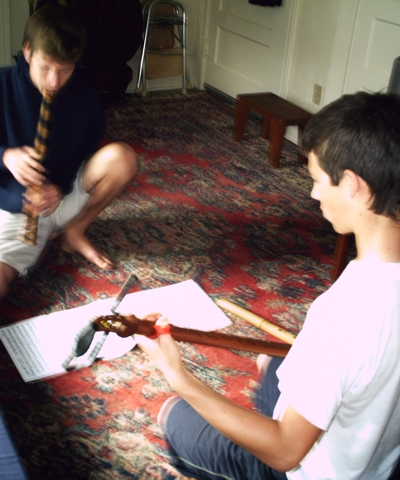
Practicing Jiuta pieces with my brother
Meeting Kevin
As fate would have it, Kevin Kmetz started playing shamisen on the Pacific Garden Mall (a few blocks from my house!) shortly after I began self-teaching myself shamisen. Surprisingly, I didn’t approach him until a few years later.
At the time, I was only interested in traditional Japanese folk songs and slow jiuta music, whereas Kevin played energetic tsugaru style shamisen (which is too recent to be considered traditional). I felt tsugaru was the “young people’s music” (I was 14, mind you) and that was something I just wasn’t interested in, so I didn’t introduce myself. (I was probably shy)

Kevin busking on the streets of Santa Cruz
At age 15, I felt comfortable with the shamisen but I didn’t know know any shamisen-specific parts or songs. I would mimic the shakuhachi melody whenever playing jiuta pieces (Kuro Kami, Chi Dori no Kyoku, etc). I eventually grew frustrated of this and yearned to learn a shamisen-specific songs or melodies. I didn’t care if it was tsugaru songs, so I finally decided to meet Kevin Kmetz!
One day, I walked up to Kevin and as an ice breaker, said “what tuning are you in?” (smooth!) He was super nice (as always) and let me try his big tsugaru shamisen. Impressed with what I could already do, he offered to teach me songs and techniques.
Kevin taught basic shamisen techniques (hajiki, sukui, etc) and form over the next few months. Rather than force me to focus on solely technique (which many strict teachers do), he focused on increasing my repertoire, knowing that bachi technique would naturally improve as I kept playing. (A point I am very appreciative of.)

Kevin, Luke (my brother) and I playing at the 2007 Japanese Culture Fair
At that time, I was insistent on solely playing traditional songs. I had an internal need for structure/tradition to balance out my wild and creative personality (I assume), so Kevin willingly taught traditional folk songs. The ironic twist is that as I grew up, that need for structure had gone away and I was ready to learn modern pieces and even start a metal band! Unfortunately, by that time Kevin had already moved to Japan. (Oh the humanity!)
Bachido’s Origin Story, Part 2: Building Shamisen
At the time of learning from Kevin, I was practicing tsugaru pieces with a nagauta-style shamisen (the relatively smaller size). Though it worked perfectly fine, Kevin’s monster-size tsugaru shamisen looked so cool!
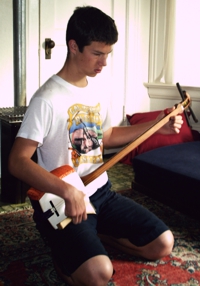
Unfortunately, he said that a good quality tsugaru shamisen would cost about $1800. Yes, that’s a high priced entry point! I couldn’t spend that much on an instrument not knowing if I’d still be interested a few months later.
My father, who’s always been an advocate of DIY, encouraged me to try making one myself. Why not? Knowing almost nothing about woodworking, making a shamisen would be a good experience.
With my dad’s jack-of-all-trade’s skill and Kevin’s generosity, we were able to reverse engineer and record the measurements and dimensions of his shamisen. After some basic practicing, I bought some hardrock maple and was ready to begin!
The thought of building any instrument can seem daunting and demanding of precision. This is surprisingly not the case for shamisen. Of course, making a professional grade shamisen takes many years of woodworking experience, but you can easily make a fun and great sounding homemade shamisen with very little skill and money. I should know, I made my first homemade shamisen at age 16 with almost no woodworking skill!

Not bad for a first attempt with no manuals nor skill!
Being almost out of high school (well, the homeschool equivilent) and having little work to do in the winter, I was able to spend about 10 hours a day in the shop, making up for lack of skill by working slowly and carefully.
The only instructional material available was a short documentary of a shamisen maker showing his craft for a Tokyo Tourism video, that was all. Studying the video was very helpful, but so much of the process was still shrouded in mystery and lack of experience.

Fortunately, my father has lots of skills ranging from building shakuhachi to house construction, so he offered me advice whenever I was confused. In three months time, I had completed my very first homemade shamisen! For the very first attempt without any written instruction, it naturally looked… ‘homemade’. But all things considered, it was definitely playable and sounded charming!

One year after completing my first homemade shamisen, I felt ready to build another one. The experience of the first attempt revealed many adjustments I wanted to make for the second. (Deeper body cavity, making the curves more rounded) The experience was just like how children first learn to walk, talk and play music – stumbling and making mistakes.
My first shamisen was nowhere close to my goal of replicating a professional shamisen, but the experience built a connection to the process and an internal understanding of where to go from there.
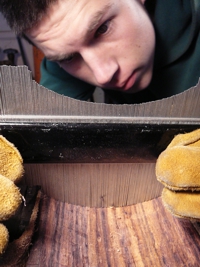
Since then, I kept making more shamisen, each time discovering new tricks and ideas which I brought to the next attempt. Eventually, I succeeded in duplicating the size, sound and feel of a professionally-made shamisen. And it all started from just jumping in with no skill!
If you have any interest to try, I would highly recommend building a shamisen for fun. There is no perfect way to do it, nor requirements to complete. Keep building and keep experimenting! Just like learning music as a child (explained in Ch 1: The Early Years), the most important point is to just experiment, explore and have fun, and the skill will grow from there!
Discovering Shami-Interest in the World
Having been inspired by the Tokyo Tourism videos, I filmed the whole construction process of my first homemade shamisen and uploaded it to the newly released Youtube. To my surprise, people were watching! Ehh?? How is this possible? What’s more, folks wrote comments such as, “This is beautiful, makes me very happy to watch.” and “… and I wonder how many INTERESTING VIDEOS have I watched recently… not many… thank you once more!!!”
I was surprised that there were other international shamisen enthustiasts! I wondered, “Was I (and my shami-buddy, Grant Reimer) not the only one interested in Shamisen outside of Japan?”

Homemade Shamisen: Newest to oldest (Left to right)
Shamisen of Japan!
After uploading the construction videos on youtube, more and more people wrote, saying they wished to learn to play or build one for themselves. I wanted to do something to help them. After all, it was all thanks to having local open-minded shamisen players (Kevin and Grant) and a knowledgeable supportive family that I was able to make and play shamisen. The knowledge I gained, however small, could be enough to help others do the same.
So while building my second homemade shamisen, I documented the entire construction process, as well as compose a how-to-play guide and compiled it all into a complete step-by-step instructional book (“Banging Zen”, later renamed to “Shamisen of Japan”).
Not only would this book provide other shamisen enthusiasts with a path to learn techniques, songs and construction, but it would be a great resource to myself if I ever forgot how to build it! (Shamisen of Japan underwent many revisions over the years, updated with new information, pictures and tricks.)
Bachido’s Origin Story Part 3: The Awakening
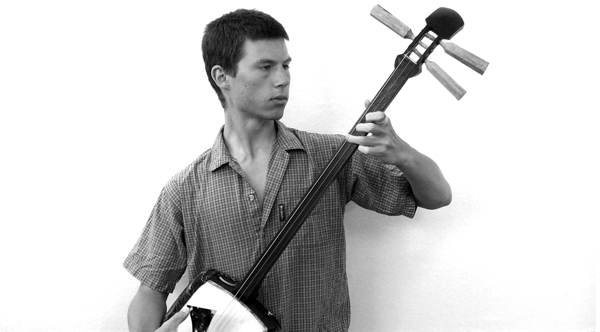
Initially, I didn’t know how long I would be interested in shamisen, which is why I built my own to save money. However, after building my third shamisen and constantly practicing songs, it was apparent that the shamisen’s unique tone had captured me.
I ended up falling in love (not in a romantic way) with the shamisen. The percussive snap of the skin, the buzzing sawari resonance, and the warm tones, it felt like the pinnacle of passion! (Again, in the artsy sense)
First trip to Japan (May 2010)
Up until now, most of my learning (both building and playing) was solely through self-teaching (a rather lonely endeavor, but I wasn’t the most social kid anyway, so it worked out).
Every year, Kevin and Grant would travel to Japan and compete in the tsugaru shamisen tournament. Each time, I decided to stay home and develop my art.
Though I didn’t go, I was still eager to experience the social world of the shamisen tournaments/conventions where hundreds of like-minded shamisen players and dozens of makers unite together.
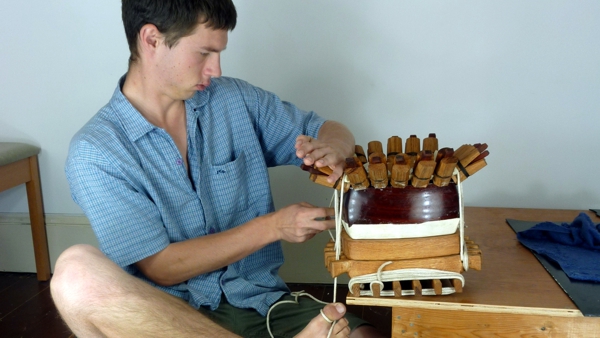
I dreamed of going to Japan for many years, but it felt important to develop my craft before turning that dream into reality. So I waited three years, building my skills until I had something to confidently show.
In 2010, I had my third homemade shamisen and some sweet riffs ready, so with a box of Shamisen of Japan books and limited Japanese skill, I got my ticket for Japan!
You can check out the “Abbotty Blogcast” to see more of my travels in Japan, but for now I will skip ahead to attending the shamisen tournament.
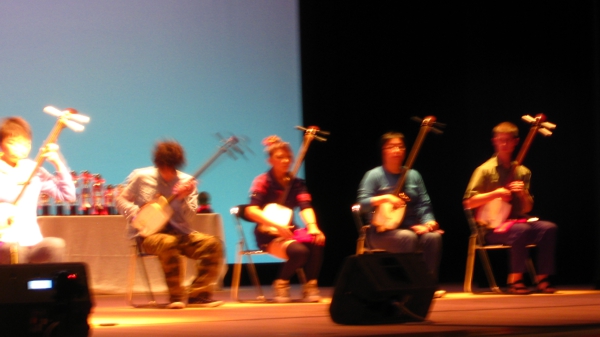
After five years of studying shamisen in rather seclusion, to finally enter an auditorium where people walked around with their shamisen felt at magical as… a kid fascinated with dinosaurs and finally entering Jurrasic Park! (Well, perhaps not the best analogy.)
Turn to the left and you see one of the Yoshida Brothers walking down the hall. Turn to the right and you see ten players rehearsing their group piece.
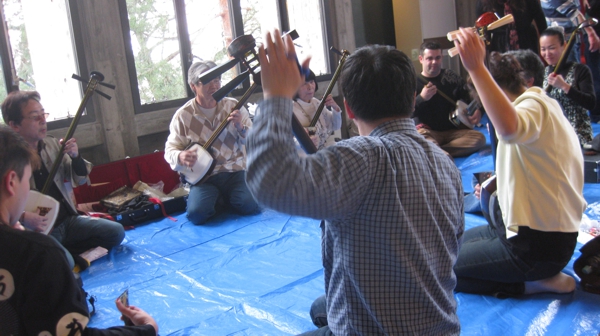
Bachi lined the tables, raw materials adorned the benches of the shamisen maker’s section, and it was all blanketed in a thundering din from hundreds of shamisen rehearsing at the same time.
Kevin was friends with many of the regular attendees, so he introduced me to them. I wasn’t a great player, so I was very glad to have my book and homemade shamisen to show I was passionate about it.

Honestly, I wasn’t sure how people would feel about my homemade shamisen or my book about building the instrument. Fortunately, the shamisen makers were very surprised and pleased to see such works. Though I previously thought all shamisen makers were private and secretive about their art, they were very happy that I was genuinely interested in their craft.
Again, my playing skill wasn’t very high, so I ended up connecting with the makers better than the players. To finally talk with real shamisen makers was so thrilling!
How did I do in the actual competition? “Watch it here!”
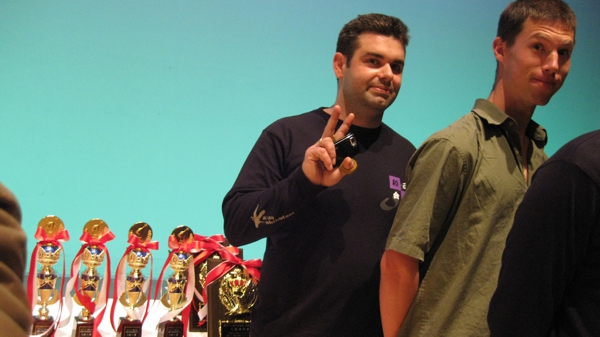
After the tournament, I went back to Tokyo and visited one of the makers. He was an incredibly talented craftsman who had a solid knowledge of sound at almost a molecular level. I had assumed someone of his great abilities would believe that there was only one ‘correct’ way to make a shamisen (a mindset I had thought was true). But his thinking was quite the opposite!
Though I’m paraphrasing, he roughly told me that “the shamisen is just wood and skin with three strings across it. There’s nothing magical about this instrument. If you have ideas for ways to adjust the shamisen’s sound or shape, there’s no reason not to do so. Keep building and keep experimenting!”
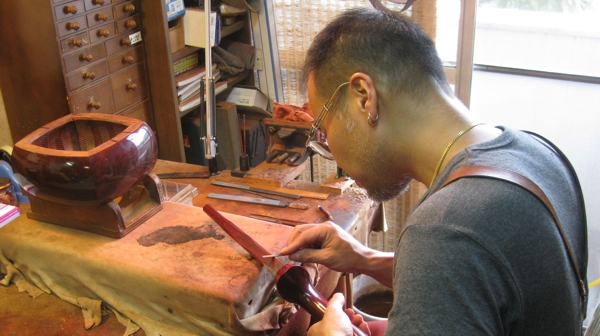
To hear this open-minded view from one of the most skilled makers in Japan completely changed the way I pursued shamisen. Though that craftsman may not have known it, the advice he gave (though paraphrased) would later greatly influence the foundation of Bachido.
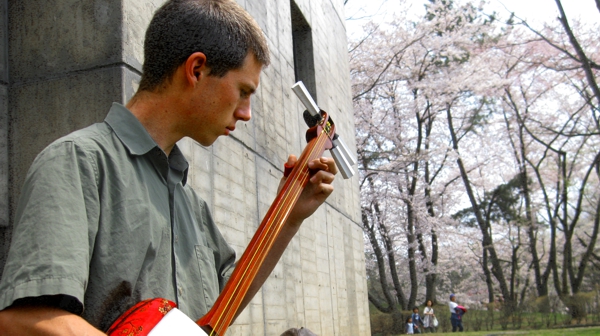
I think of this tournament adventure as an awakening experience. I learned so much from years of self-practice, but the tournament opened my eyes to a completely new experience – the social aspect of the shamisen world.
To be surrounded in everything/everyone shamisen brought a whole new level of immersion. When I returned home from that experience, I could viscerally feel what was needed for international shamisen enthusiasts: Community!
Bachido’s Origin Story Part 4: The Birth of Bachido
Returning from my first trip to Japan was a bit of a challenge, and one of the questions I faced was where to go with shamisen from there? Up until now, shamisen was only a side project in my life.
However, worldwide orders for Shamisen of Japan steadily continued since it’s release in 2009. Real proof of worldwide shamisen interest was a great surprise to my family as well as myself, so I had a bit more allowance to further pursue this project.
With Shamisen of Japan available, people finally had a resource for learning shamisen on their own. Judging from the customer’s shipping addresses, I could see that many people actually lived quite close to each other.
Going to Japan and seeing shamisen enthusiasts come together at tournaments (despite the competitiveness), it became apparent that the next step was to form an international community and bring all shamisen enthusiasts together (in a supportive environment).
So I spent the next year composing the foundation of an international community with the underlying goal of providing all the resources to make shamisen as accessible as possible.
In this new international shamisen community, I wanted to give newcomers the resource to learn the basics of shamisen in a free, easy-to-use crash course. Next, I wanted people to be able to obtain their shamisen and accessories with ease of mind. And above all, I wanted a forum where people could exchange ideas and encourage each other.

After lots of writing and coding (thanks to my brother/Boy Genius Luke, who’s 20+ years of programming experience was paramount), Bachido was founded and those three resources (mentioned above) were created!
The First Three Resources of Bachido:
Free Crash Course
Before releasing Bachido, I spent about 3~6 months making a free crash course so anyone could immediately start learning shamisen. My father had zero shamisen experience, so he was the perfect beta tester!
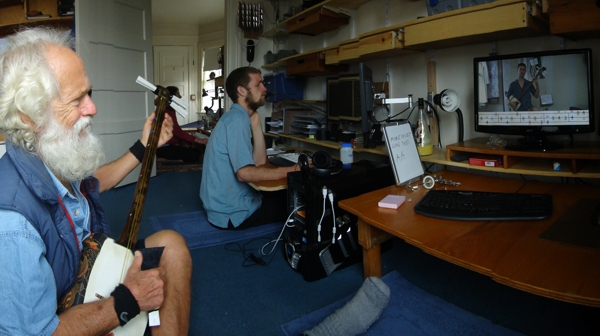
Pops trying out the Crash Course (before his brain overheated)
After filming what I thought was a great simple course, I gave my father a shamisen and he tried it out. Within five minutes, he handed the shamisen back to me saying, “This is impossible for beginners.” In hindsight, he was right. I was trying to teach Rokudan (a “basic” but difficult tsugaru piece) in the first lesson! What was I thinking??
This experience formed another pillar of the Bachido mindset: Keep it simple! I rewrote the material many times until finally composing a course that he could understand and play along with. If he (a complete beginner) could easily use this course, I knew that 98% of users would be able to learn shamisen with great ease. (So far, that’s proven to be true!)
The Bachido Store
A major difficulty in starting shamisen is actually getting a shamisen. Most online shamisen shops aren’t written in english, and with the few that are, there’s very little detailed information about the instruments and accessories. Thus, I wanted to present the Bachido Store as a place to learn about the shamisen and it’s accessories, and acquire them comfortably.
So, I contacted my friend Masahiro Nitta (who visited Santa Cruz with Kevin many years prior) and asked if he had any suggestions for suppliers. As it turned out, he was about to start his own shamisen shop! So at that point, we teamed up to provide the world with an all-English resource for shamisen goods straight from Japan!
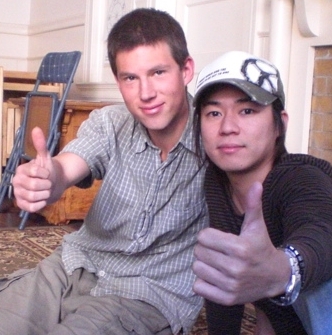
Nitta-san and I, Pre-Bachido (2008)
Community
The main pillar of the Bachido, the community. Because Luke had developed a great community setup for my family’s site, The Toneway Project, he could simply port that over to Bachido!
Admittedly, I didn’t think the community would be very active. A day after Bachido was unveiled and a few folks signed up, someone posted a question. I sighed and thought, “I guess I’ll have to be the main responder/moderator here.” But to my great surprise, within a day, someone else signed up to Bachido and gave a very knowledgeable answer!
Ever since then, more and more people kept coming, either with newfound interest in shamisen or experienced players wanting to be part of the community.
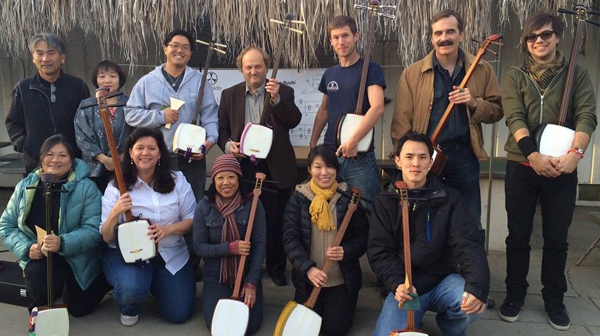
Bachido Shamisen Workshop held by Bachido Instructor Aki Takahashi and myself
The Growth of Bachido
Bachido has grown so much since 2011. Bachido now features a Schoolhouse where everyone can learn new songs and skills from talented Bachido-certified shamisen instructors. I’ve also started an educational Blog to bring more depth to technique questions, engage in theoretical subjects of shamisen, and read the experiences of other Bachido members!
As of recently, we’ve started workshop events (ShamiCamp), literally bring our community together to enjoy the social bonding and friendships which I experienced in Japan! (Of course, based in supportive education rather than a competitive tournament.) Hand-in-hand, we’re continuing to grow and develop our goal of spreading shamisen instruction with fun and passion!
Principles of the Bachido
Starting from the explorative way I learned music as a child all the way to the open-minded approach from many talented shamisen players and makers, everything mentioned in these four articles is what built the foundation of Bachido. Namely, encouraging and celebrating everyone’s ideas and exploration with the shamisen.
Everything I learned was from the generosity of many, so writing Shamisen of Japan and starting Bachido felt like my way to give back to the world. To my delight, almost everyone in the Bachido Community shares this open-minded view. What’s more, they too give back to the community by enthusiastically helping new beginners and encouraging us all to strive on with passion!
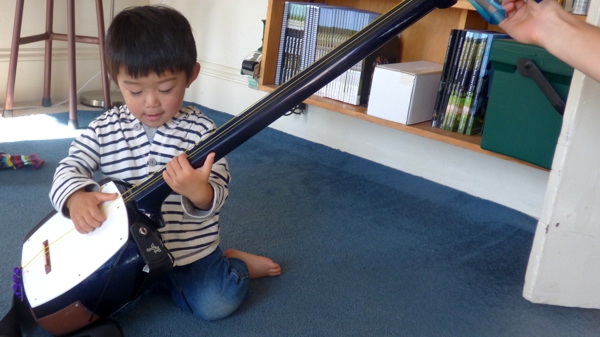
Note: This child isn’t mine.
I truly feel that anyone can play shamisen and bring out something special inside them while they bring sound out of the instrument. There’s something in shamisen for all of us. Let’s see what we can do with it, and most importantly, have fun!!
Bachi on!!
Kyle Big K Abbott
Founder of Bachido




